June 3, 2018
“How we spend our days is, of course, how we spend our lives.
– Annie Dillard
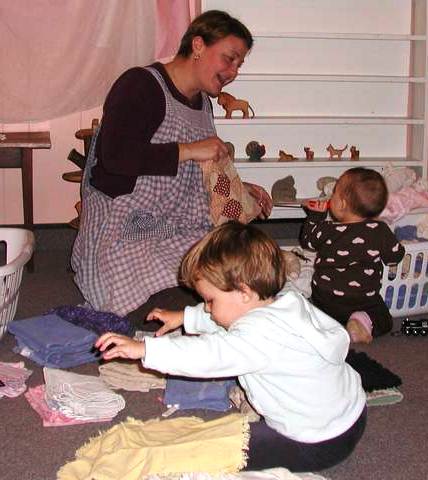
The Living Arts are nourishing practices that help us meet the developmental needs of the young child. They are comprised of what LifeWays’ founder Cynthia Aldinger categorized as: practical tasks of the household like cooking, repairing, sweeping, polishing, and washing; social tasks such as writing thank you notes, visiting friends, and shopping at the farmer’s market; nurturing care, such as hair brushing, bodily care, and diaper changing; and creative exploration such as coloring, painting, circle time, puppetry and stories. And guess what…these arts of living are very nourishing for us adults as well. When we are feeling out of balance, a return to the Living Arts often helps us to re-center and come back into wholeness.
You’ll notice that each week, our Living Arts blog features a little tidbit for each of these four areas: Practical Activity, Social Awareness, Nurturing Care and Creative Exploration. This week we celebrate “the art of living” with offerings from various members of our LifeWays community, in which they share some unique ways they bring these Living Arts to life. What is your favorite way to practice the Living Arts? Share in the comments below!

Mary O’Connell, Your Living Arts Weekly Editor
Practical Activity
Mukimono from Pamela Perkins
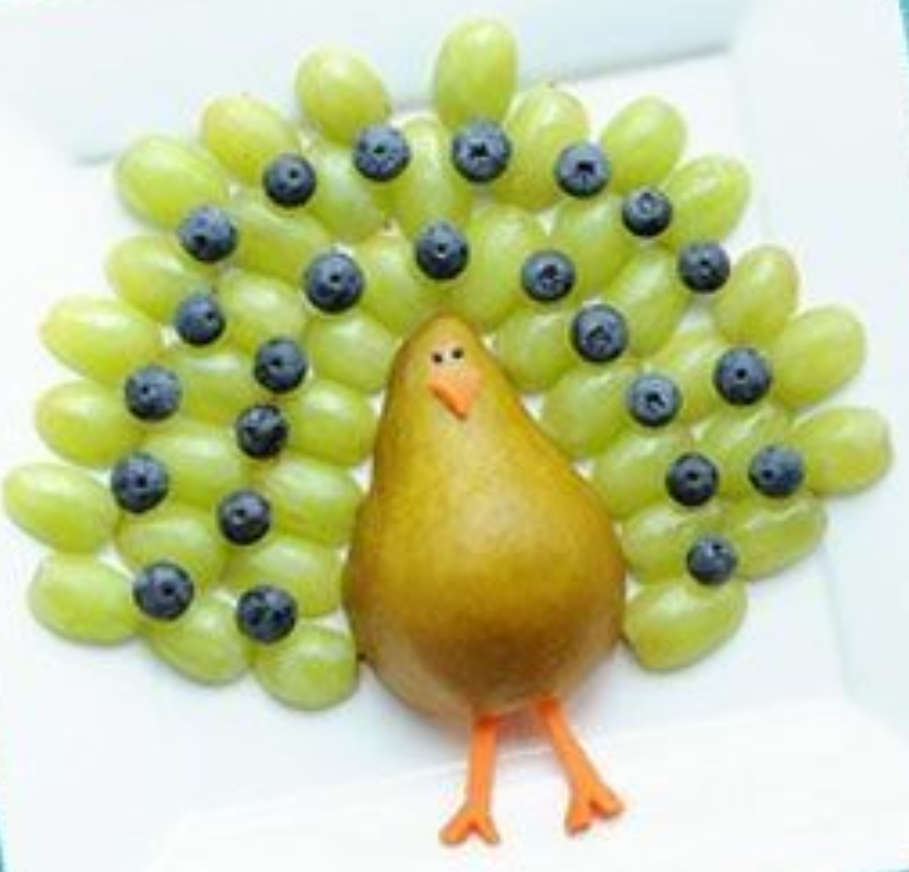
The ancient art of mukimono, or food garnishing, came into its own during the Edo Period of Japanese culture (1603-1867). Check your local library or bookstore for more information and ideas. Pinterest is a wonderful source for ideas, often with instructional videos.
A broad range of imaginative delights can be made using readily available vegetables and fruits plus a few simple tools (basically a good quality, sharp, paring knife, a thin-bladed Japanese chef’s knife, and a ¼” V-shaped chisel). Let your imagination soar!
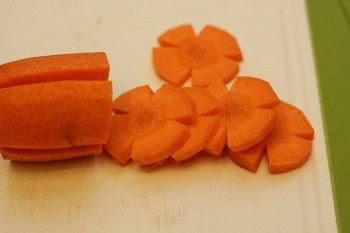
VERY SIMPLE CARROT FLOWERS
(a project for adults or older children with adult supervision)
- Cut a l – 1 ½” section of uniform diameter from a fresh carrot (you needn’t restrict yourself to carrots – experiment).
- Shape the piece as shown using a sharp thin-bladed knife. Try animal, bird or other flower shapes.
- 3. Slice into thin garnishes. Serve raw or drop the pieces into lightly salted boiling (1 tsp salt, 2 cups water) until just done or until the garnishes turn a bright orange.
Not to be overlooked are real edible flowers!
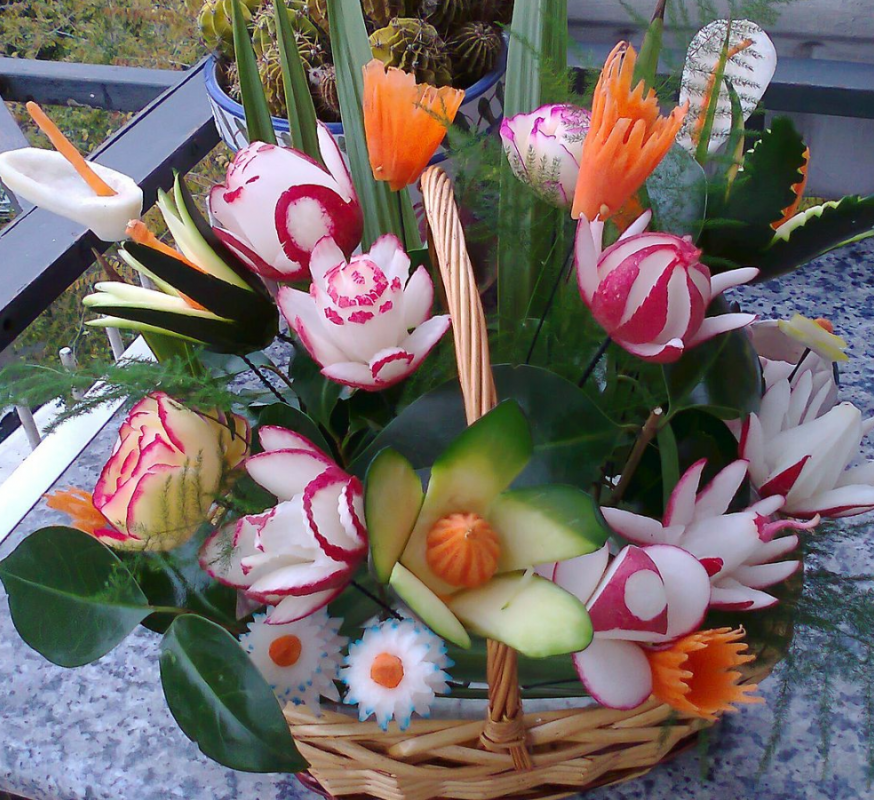
Nurturing Care
From Lullabying Throughout Childhood, by Holly Richardson, Boulder LifeWays Training graduate (You can read Holly’s entire article here.)
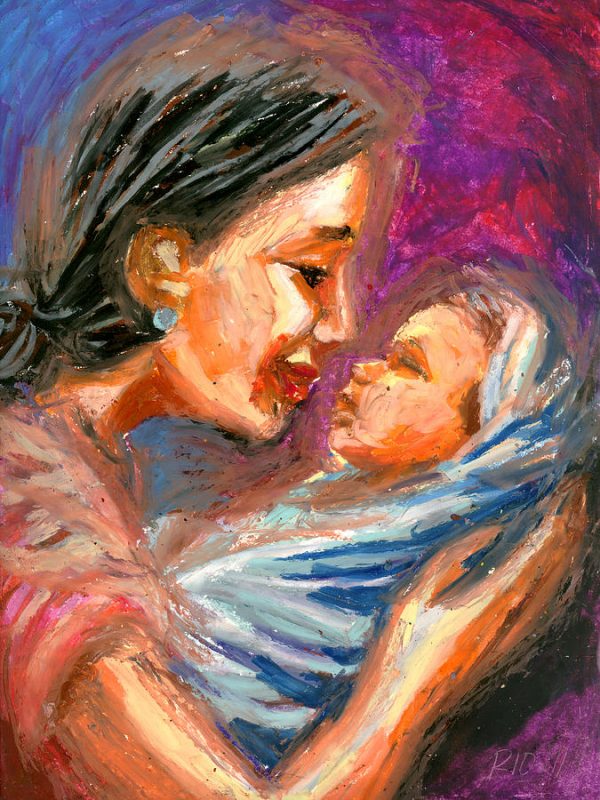
When I was a little girl, my parents would sing to me at bedtime. After saying prayers, my father would sing a song from his alma mater that began, “Aye zigga zoomba zoomba zoomba!” Fast forward a few decades to the night my first son was born: I remember lying in bed in a dark room, holding him for the first time. I sang to him, just a few hours old. Tears streamed down my cheeks, and I was touched with a deep love that I had never experienced before. Out of this was born a habit of singing to my children, especially at bedtime. I found singing at naptime and nighttime to be part of a soothing and connecting routine, both for my children and myself. I maintained this ritual until my children reached adolescence.
Here are a few tips for parents new to lullabying:
- Begin gradually winding down the mood prior to bedtime by slowing your movements, softening your voice, darkening the room, etc.
- Relax yourself so you can embody calmness
- Keep your songs simple and soft
- Pair singing with rocking and gentle jiggling for an infant to offer a “womb-like experience”
- Make your song the final part of a consistent bed time ritual
- Stop singing before your child is completely asleep so your child can learn to fall asleep on its own
- Consider incorporating the gentle music of a pentatonic kinder lyre * More on this in a future article!
A wonderful resource is Mary Schunemann’s The Wonder of Lullabies.
Creative Exploration
from Sharifa Oppenheimer, the author of Heaven on Earth: A Handbook for Parents of Young Children and What is a Waldorf Kindergarten. She taught young children for 35 years and now loves teaching adults through the LifeWays trainings. She also travels offering lectures which explore the ways in which the latest findings in brain research support Steiner principles. Sharifa lives with her husband in an enchanted forest in Virginia, and is the mother of three grown sons, who were raised within the Waldorf tradition.
Leaf-y Fun Outdoors
Late spring brings its proliferation of leaves; to children of all ages these look like toys sent from the Earth mother Herself! Your children will find many leaf games on their own: a flag atop the sand castle, an ornament for the hair, a salad to make for the fairies or shredded into a potion for the bad guys. We can help spark their imagination too! How about Leaf Crowns and Leaf Boats?

Leaf Crown:
—bring a small pair of scissors and a toothpick outdoors with you
—with your child gather a lap full of fresh supple leaves with their stems attached.
—lay the top part of one leaf onto the bottom part of another.
—snip the stem off and use it as a “hat pin”, attaching the leaves together.
—use the toothpick to make holes for the stem to go through
—make a chain of leaves the size of your child’s head.
—attach the last leaf to the first
—admire the Leaf Child before you!
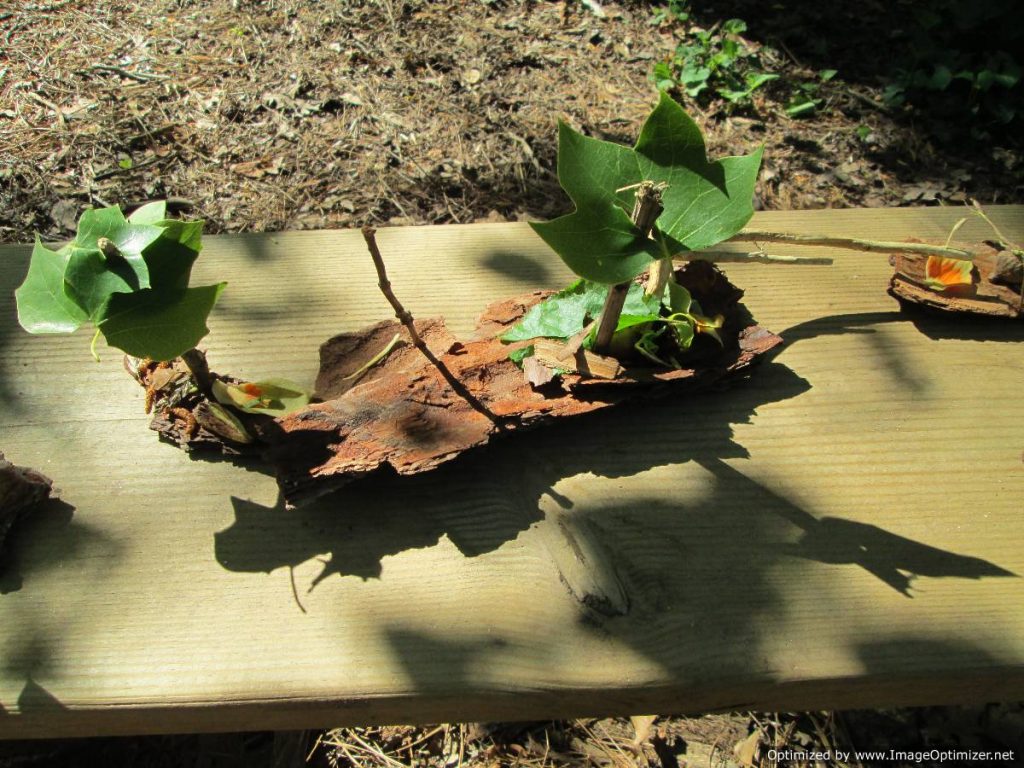
Leaf Boat:
—bring a small hand turned drill or a large screw and screw driver outdoors
—bring glue, too!
—begin with a good sturdy piece of bark; pine is great
—gather a supply of leaves, and some strong, thin sticks
—choose where the sails of the boat will go
—drill hole or make hole with screw
—make sails with the sticks and leaves
—put a drop of glue in the hole
—insert the sails
—adorn the boat with flowers, seeds, nuts and other ornaments
—people the boat with tiny pocket dolls
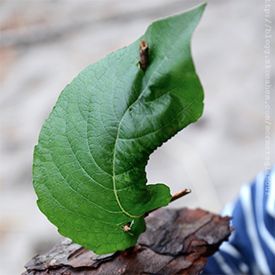
Social Awareness
The master in the art of living makes little distinction between his work and his play, his labor and his leisure, his mind and his body, his education and his recreation, his love and his religion. He hardly knows which is which. He simply pursues his vision of excellence at whatever he does, leaving others to decide whether he is working or playing. To him he is always doing both.
(Quote attributed to a variety of sources!)
Daphne The Curious Little Donkey Meets Henrietta and Hector
This is the first installment of a new story from Pamela Perkins, about some of our favorite animal friends.
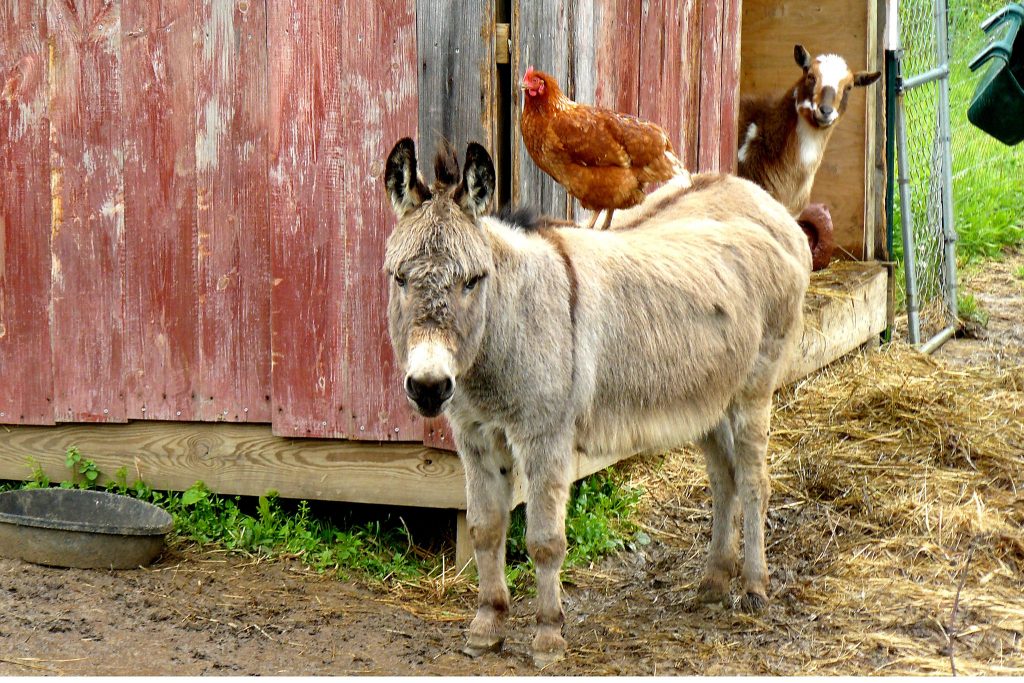 Pamela Perkins has worked with and for children in various capacities since 1970. A former Waldorf teacher, LifeWays graduate and home provider, she now delights in being with her five granddaughters, plus creating magical needle-felted puppet stories and writing gentle tales to nurture young and old. She lives in the Upper Valley of Vermont, and is working on her new writing project Silver Seedlings – Nurturing Tales for the Young and Young at Heart.
Pamela Perkins has worked with and for children in various capacities since 1970. A former Waldorf teacher, LifeWays graduate and home provider, she now delights in being with her five granddaughters, plus creating magical needle-felted puppet stories and writing gentle tales to nurture young and old. She lives in the Upper Valley of Vermont, and is working on her new writing project Silver Seedlings – Nurturing Tales for the Young and Young at Heart.
Introduction
This is a story about Daphne, an unusually curious little donkey with a sense of adventure, and about the day she discovered her very special gifts.
Daphne lives on a small farm in Northern Vermont. The farm and its’ fields are surrounded by gently rolling hills that are forested with evergreen trees, as well as maples, oaks, beech and birch.
Several streams flow through the property. The stream flowing out of the woods along the edge of East Meadow empties into the farm pond. Another pond, deep and cool and lovely for swimming, lies over beyond South Hill, through the pine grove, and down into a grassy open area surrounded by many sugar maples.
Daphne has her own stall in the barn, which she shares with many other animals. There are a lot of scatter-brained chickens, a beautiful little goat named Pumpkin and her two kids, Cinnamon and Spice, and an old gentle draft horse named Frederick, who is a wonderful storyteller. Velvet, the Jersey cow with soft brown eyes, recently had her first calf, Violet.
This story takes place on a morning in early June when Daphne was feeling very, very curious, and had an idea. This idea led to an adventure which placed her in just the right place at just the right time. What happened next helped Daphne to discover her very special gifts.
Chapter One – Donkey Dreams and Squawking Chickens
The sun was shining in a clear blue sky. Daphne was enjoying a nap under the shady oak trees by the edge of the pasture. Next to her, Frederick the gentle old draft horse was also dozing, shifting slightly from foot to foot. Velvet, the Jersey cow with soft brown eyes lay near them in the sun, flicking flies from her ears. She placidly chewed her cud while she watched her calf Violet gambol and frisk with Cinnamon and Spice, Pumpkin’s lively kids. Pumpkin wandered here and there, nibbling at the choicest bits of grasses or leaves along the hedgerows, the way goats love to do. The chickens were clucking and scratching, and scratching and clucking, with occasional excited ‘buk-buk-buk-buk’ announcements when they made delicious bug discoveries.
Daphne sighed contentedly in her little donkey dreams. Life was good. She loved her animal friends and considered them all to be part of her herd, even the chickens who could sometimes act so silly, squawking and flapping all around. She loved the cozy barn and her own snug stall. Most of all, she loved Maeve, the farm girl who belonged to her (in Daphne’s mind, this is how things went!)
This was Daphne’s first Summer, for she had been born early the previous September, when the goldenrod and purple asters and Black-eyed Susan bloomed, and all of the forest animals were busy preparing for the long cold winter ahead. Daphne loved every part of Summer so far: the warmth, all of the delicious grasses and bramble leaves and flowers to nibble, the beautiful starry nights, and long, lazy days wandering and exploring the fields and meadows. Occasionally, she went exploring in the woods as well – but only with Maeve. She had learned an important lesson about going off on her own earlier that Spring. On this morning, she felt deliciously comfortable and drowsy, yet was still vaguely aware of the buzzing of bees in the clover, the sounds of the younger animals playing, of the hens’ chatter, and of the birds swooping and darting here and there on their various errands. Daphne’s long silky ears twitched and turned this way and that, even in sleep.
A squabble among some of the hens interrupted a particularly lovely dream she was having.
“Humph! Chickens!”, she muttered, shaking her head with annoyance. But, she quickly recovered her good spirits, and decided to go wander along the hedgerow where some of her favorite bramble bushes grew, and to forget about ‘All that fluff, flap and flutter over a worm!”
Daphne was a browser, and loved to leisurely nip a bite here, then nip a bite there, while ambling along just feeling content and enjoying what the day might bring. She had a keen sense of hearing and a keen sense of smell: these made every walk around the pasture an adventure. She never knew what she might discover- or whom she might meet. The faint sound of yet another series of squawks reminded her that she wanted to visit her newest friends Henrietta and Hector, who had recently arrived from far, far away across the blue ocean. Daphne wasn’t certain she understood what an ‘ocean’ was, except that it was a very, very, very big pond that tasted salty. “Yuck!” she thought. “Who would want to live next to that!” She was glad she had fresh, clear water to drink, in the pond, or the streams or at the barnyard.
Chapter Two – How Daphne Met Henrietta and Hector
When Maeve first told her about the new arrivals, Daphne was very curious and right away wanted to go meet them. They were different from the chickens she knew, Maeve had explained, and they had so many interesting tales to tell. “But you will have to be patient and wait just a few more days,” Maeve told her, “Then I will have time to bring you out to meet them, even if my parents do not let all of the animals out in the pasture for the Summer.” Daphne felt she would burst with excitement and anticipation, and every day she made her restless complaining noises when Maeve came to feed her. Maeve understood; she patted Daphne and gave her a hug, explaining that it was still too muddy and too cool at night for a little donkey, or for the other animals, to stay out for the Summer, and that the pasture needed more time to ‘wake up and turn greener’ Winter and the cold weather had overstayed their welcome this year. Probably within the next few days, the time would be right. Daphne sighed.
Each morning after Maeve had told her about going to see Henrietta and Hector, Daphne would go out into the barnyard and gaze longingly over the fence at the pastures and hills beyond. Every day, the grasses grew greener and taller; more and more flowers opened up in the farmhouse garden and yard. She observed the leaves unfurling, and she could hear new bird calls. She sometimes had to do a little dance around the yard and kick up her heels, to work off her curiosity energy. The time seemed to creep by, like a snail moving along the fence rail.
She was careful not to lean on the fence, even though she was tempted too, because now Cinnamon and Spice and Violet followed her everywhere. She took her job as “oldest cousin” very seriously. Maeve had told her that the younger animals looked up to her and liked to do whatever she did. Daphne thought this was a rather silly thing to say, since Violet was actually bigger than she was, and Cinnamon and Spice would soon be taller as well…not by much though, and Daphne would always weigh more and be stronger. Daphne also knew that Maeve trusted her to leave the fence alone. She shuddered slightly, remembering her misadventure weeks before, and how miserable she had been out in the forest during that sudden late Winter snowstorm, and while recovering from her cold for two full weeks after that. Besides, Maeve’s father and the farm apprentice who helped him, had repaired the fence, so that it was now sturdy and strong. Daphne, always very curious, had carefully tested it, just to make sure.
Three days later, Maeve came out to the barnyard after school. As she had promised, she put on Daphne’s halter and took hold of her the lead rope. The animals would be let out that weekend, but today Daphne would go with Maeve to meet Henrietta and Hector. The two of them walked through the barnyard gate, out along the hedgerows and then down to the Farm Pond that lay at the bottom of a shallow dingle in East Meadow. The day was bright and clear, with a warm, light breeze. Daphne trotted along eagerly, delighted to be out with Maeve, and fairly itching with curiosity about Henrietta and Hector.
As they approached the stream that flowed out of the woods into the pond, Daphne watched how it bubbled happily over the stones, as if it too were excited on this lovely day. As they approached the pond, Maeve slowed down and whispered, “Do you see those cattails? The ones where Cheeree-chee and his mate and the other Redwings live? I am going to toss some cracked corn onto the grass over there by the edge of the water; then we will stand quietly and watch.”
With that Maeve reached into her pocket, drew out a handful of grain and tossed in onto the smooth flat area at the edge of the pond. She made a high-pitched chick-chick-chick call. They waited. Within a minute, out popped Henrietta’s bright golden head. Close behind her Daphne spotted the prettiest, most colorful little rooster she had ever seen. Hector!
Cautiously, the two bantams looked around. When they spotted Maeve, whom they knew quite well by now, they relaxed and came all of the way out from the reeds. Then they looked at Daphne. She was very big, much bigger than a dog or pua’a – a pig. But she had a soft nose and gentle eyes and did not run at them like fox or coyote. They looked back at each other and silently nodded in agreement: this new creature was safe, AND she was with Maeve.
“ Brrruk,brrruk,brrrruk,” exclaimed Hector as the two raced over to the grain and began to peck enthusiastically. “Bluuuk, bluuuk, brrrrrruk,” replied Henrietta. They two just loved the cracked corn.
After they finished, they shook their feathers and began to preen. Slowly, very slowly, Maeve and Daphne approached … but not too close. Daphne’s eyes opened wide as Hector strutted about, the sun glistening off his long iridescent blue-green tail feathers, and his gold and rust ruff and back. Henrietta’s soft dove grey body was covered from the top of her head all the way down her back with a golden cape of feathers. Before Daphne could stop herself, she let out a joyous Hee-Haw of delight. The two birds jumped straight up into the air, then dashed off into the cattail and rushes again. Daphne was sad, she had not meant to frighten them. Maeve patted her gently and said, “I will toss more grain, but this time you must speak much more softly.” Maeve used her special quiet chicken calling voice this time and tossed more cracked corn onto the ground. Daphne stood very, very still. Sure enough, both bantams came back out. In her quietest donkey whisper Daphne apologized to Henrietta and Hector and explained that although her happy voice was loud, she meant no harm.
Before long, they were chatting like old friends. At last, all of the corn was gone, and it was time for Maeve and Daphne to head back to the barnyard. Daphne promised to visit again as soon as she and the other animals were out in the pasture.
(Tune in to next week’s Living Arts Weekly to read more about Daphne, Henrietta and Hector.)